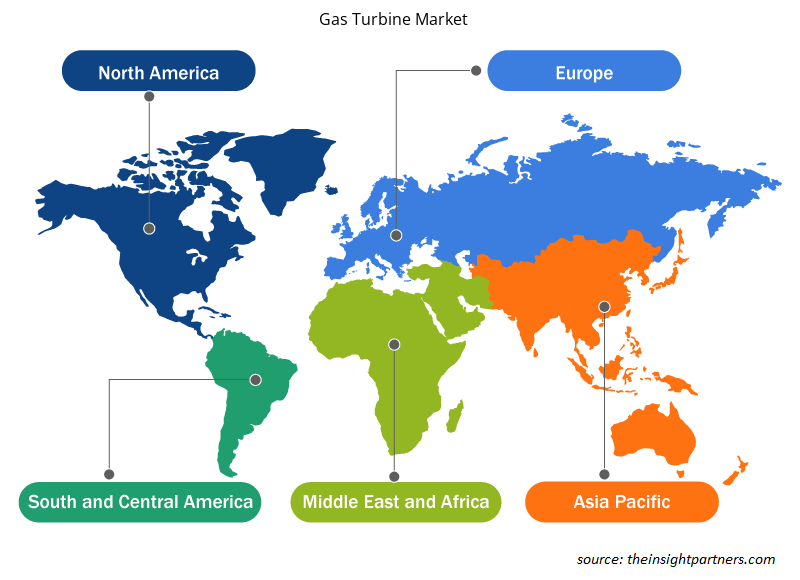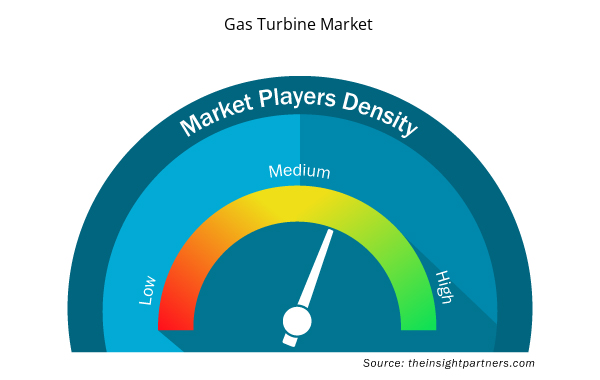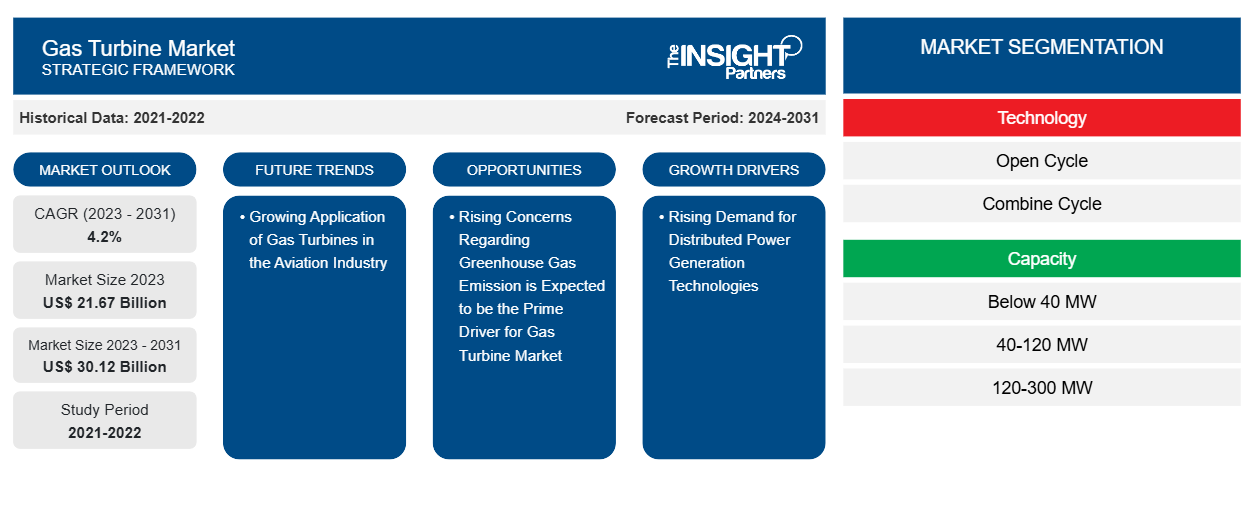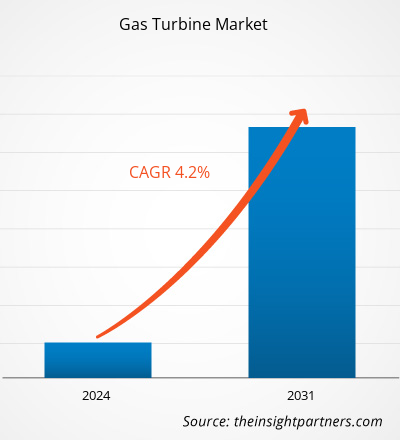ガスタービン市場の規模は、2023年の216億7,000万米ドルから2031年には301億2,000万米ドルに達すると予測されています。市場は2023年から2031年にかけて4.2%のCAGRを記録すると予想されています。エネルギー分野における技術進歩の進展と分散型発電技術に対する需要の高まりは、ガスタービン市場のその他のトレンドです。
ガスタービン市場分析
環境問題への懸念の高まりとエネルギー需要の増加は、世界的にガスタービンの需要を押し上げる主な要因の一部です。低炭素排出を目標とする発電技術に対する世界規模の政府支援政策の増加も、市場の主要な推進力として機能しています。石炭ベースの発電からガス駆動プロセスへの消費者の移行は、予測期間中にガスタービン市場の進化を推進すると予想される主要なトレンドの 1 つです。
ガスタービン市場の概要
人口増加と急速な工業化に伴い、エネルギー需要も世界中で高まっています。ガスタービンは、発電においてはるかに環境に優しい選択肢であり、ガスタービン市場の主要な推進要因となっています。他の燃焼駆動発電技術と比較して、ガスタービンは有能であり、炭素排出量も少なくなっています。いくつかの気候変動イニシアチブの実施と、GHG排出量を削減するための規制の施行により、予測期間中にガスタービンの需要が増加すると予想されます。
要件に合わせてレポートをカスタマイズする
このレポートの一部、国レベルの分析、Excelデータパックなど、あらゆるレポートを無料でカスタマイズできます。また、スタートアップや大学向けのお得なオファーや割引もご利用いただけます。
- このレポートの主要な市場動向を入手してください。この無料サンプルには、市場動向から見積もりや予測に至るまでのデータ分析が含まれます。
ガスタービン市場の推進要因と機会
温室効果ガス排出に関する懸念の高まりがガスタービン市場の主な原動力になると予想される
ガスタービンは、石炭を動力源とする技術よりも環境に優しい発電の代替手段と考えられています。環境保護に対する関心の高まりと、環境への悪影響が少ないより高度な発電技術に対する需要の高まりが、世界的に市場の成長を刺激しています。急速な工業化と発電への化石燃料の適用による環境汚染の拡大は、ガスタービンに対する消費者の需要を牽引する主な懸念事項の一部です。温室効果ガスの排出を緩和するという目標を掲げ、石油・ガス、化学、製造業などさまざまな産業向けに、より環境に優しい発電技術を推進する政府の取り組みが拡大していることが、ガスタービン市場の主要な推進力となっています。
航空産業におけるガスタービンの応用拡大
航空業界におけるガスタービンの普及は、市場の成長機会の 1 つです。ガスタービンは、航空機の推進システムに適したパワー対重量比で知られています。ガスタービンは発電効率も高く、これもガスタービン市場にチャンスをもたらすと予想されています。
ガスタービン市場レポートのセグメンテーション分析
ガスタービン市場分析の導出に貢献した主要なセグメントは、技術、容量、およびアプリケーションです。
- 技術に基づいて、市場はオープンサイクルとコンバインドサイクルに分けられています。コンバインドサイクルセグメントは2023年に大きな市場シェアを占めました。
- 容量の面では、市場は40MW未満、40〜120MW、120〜300MW、300MW以上に区分されています。2023年には120〜300MWのセグメントが市場を支配しました。
- 用途別に見ると、市場は発電、石油・ガス、産業に分かれており、2023年には発電セグメントが市場を支配しました。
地域別ガスタービン市場シェア分析
ガスタービン市場レポートの地理的範囲は、主に北米、ヨーロッパ、アジア太平洋、中東およびアフリカ、南米の 5 つの地域に分かれています。
2023年にはアジア太平洋地域がガスタービン市場を支配しました。アジア太平洋地域には、オーストラリア、中国、インド、日本、韓国が含まれます。人口の増加とエネルギー需要の増加は、アジア太平洋地域の市場の主要な成長推進要因となっています。さらに、化石燃料への依存を減らして炭素排出量を削減するための支援政策や対策を採用することに政府がますます重点を置いていることが、アジア太平洋地域の市場の成長を導くと予測されています。中国はアジア太平洋地域で注目すべきプレーヤーであり、2023年にはインド、日本、オーストラリアがそれに続きます。アジア太平洋地域におけるガスタービンプレーヤーの高い存在感は、アジア太平洋地域の市場の主要な推進力となっています。急速な工業化、都市化の進展、エネルギー需要の増加は、アジア太平洋地域の市場の成長を後押しする主な要因の一部です。
ガスタービン市場の地域別分析
予測期間を通じてガスタービン市場に影響を与える地域的な傾向と要因は、Insight Partners のアナリストによって徹底的に説明されています。このセクションでは、北米、ヨーロッパ、アジア太平洋、中東、アフリカ、南米、中米にわたるガスタービン市場のセグメントと地理についても説明します。

- ガスタービン市場の地域別データを入手
ガスタービン市場レポートの範囲
| レポート属性 | 詳細 |
|---|---|
| 2023年の市場規模 | 216億7千万米ドル |
| 2031年までの市場規模 | 301.2億米ドル |
| 世界のCAGR(2023年~2031年) | 4.2% |
| 履歴データ | 2021-2022 |
| 予測期間 | 2024-2031 |
| 対象セグメント | テクノロジー別
|
| 対象地域と国 | 北米
|
| 市場リーダーと主要企業プロフィール |
|
市場プレーヤーの密度:ビジネスダイナミクスへの影響を理解する
ガスタービン市場は、消費者の嗜好の変化、技術の進歩、製品の利点に対する認識の高まりなどの要因により、エンドユーザーの需要が高まり、急速に成長しています。需要が高まるにつれて、企業は提供を拡大し、消費者のニーズを満たすために革新し、新たなトレンドを活用し、市場の成長をさらに促進しています。
市場プレーヤー密度とは、特定の市場または業界内で活動している企業または会社の分布を指します。これは、特定の市場スペースに、その規模または総市場価値と比較して、どれだけの競合相手 (市場プレーヤー) が存在するかを示します。
ガスタービン市場で事業を展開している主要企業は次のとおりです。
- アンサルド・エネルギア
- ゼネラル・エレクトリック・カンパニー
- ハルビン電気株式会社
- 川崎重工業
- 株式会社
免責事項:上記の企業は、特定の順序でランク付けされていません。

- ガスタービン市場のトップキープレーヤーの概要を入手
ガスタービン市場のニュースと最近の動向
ガスタービン市場は、主要な企業出版物、協会データ、データベースを含む一次調査および二次調査後の定性的および定量的データを収集することによって評価されます。以下は、ガスタービン市場の市場動向と戦略のリストです。
- 2024年4月、GE Vernovaのガス発電事業は、韓国西部発電株式会社から、韓国忠清南道公州市のKOWEPO発電所向けにGE Vernova H65発電機と7HA.02ガスタービンを受注したことを発表しました。(出典: GE、プレスリリース/会社ウェブサイト/ニュースレター)
- 2024年1月、GE VernovaとIHI株式会社は、アンモニアを発電用の燃料として利用できることが期待され、GE Vernovaの7F、9F、6F.03ガスタービンにも適合する新しいガスタービン燃焼器を開発するプロジェクトで協力しました。(出典:GE、プレスリリース/会社ウェブサイト/ニュースレター)
ガスタービン市場レポートの対象範囲と成果物
「ガスタービン市場規模と予測(2021〜2031年)」レポートでは、以下の分野をカバーする市場の詳細な分析を提供しています。
- 対象範囲に含まれるすべての主要市場セグメントの世界、地域、国レベルでの市場規模と予測
- 市場の動向(推進要因、制約、主要な機会など)
- 今後の主な動向
- 詳細なPEST分析
- 主要な市場動向、主要プレーヤー、規制、最近の市場動向を網羅した世界および地域の市場分析
- 市場集中、ヒートマップ分析、主要プレーヤー、最近の動向を網羅した業界の状況と競争分析
- SWOT分析による詳細な企業プロフィール
- 過去2年間の分析、基準年、CAGRによる予測(7年間)
- PEST分析とSWOT分析
- 市場規模価値/数量 - 世界、地域、国
- 業界と競争環境
- Excel データセット


- Constipation Treatment Market
- Micro-Surgical Robot Market
- Third Party Logistics Market
- Drain Cleaning Equipment Market
- Digital Language Learning Market
- Explosion-Proof Equipment Market
- USB Device Market
- Artificial Intelligence in Healthcare Diagnosis Market
- Water Pipeline Leak Detection System Market
- Joint Pain Injection Market

Report Coverage
Revenue forecast, Company Analysis, Industry landscape, Growth factors, and Trends

Segment Covered
This text is related
to segments covered.

Regional Scope
North America, Europe, Asia Pacific, Middle East & Africa, South & Central America

Country Scope
This text is related
to country scope.
Trends and growth analysis reports related to Energy and Power : READ MORE..
The Insight Partners performs research in 4 major stages: Data Collection & Secondary Research, Primary Research, Data Analysis and Data Triangulation & Final Review.
- Data Collection and Secondary Research:
As a market research and consulting firm operating from a decade, we have published and advised several client across the globe. First step for any study will start with an assessment of currently available data and insights from existing reports. Further, historical and current market information is collected from Investor Presentations, Annual Reports, SEC Filings, etc., and other information related to company’s performance and market positioning are gathered from Paid Databases (Factiva, Hoovers, and Reuters) and various other publications available in public domain.
Several associations trade associates, technical forums, institutes, societies and organization are accessed to gain technical as well as market related insights through their publications such as research papers, blogs and press releases related to the studies are referred to get cues about the market. Further, white papers, journals, magazines, and other news articles published in last 3 years are scrutinized and analyzed to understand the current market trends.
- Primary Research:
The primarily interview analysis comprise of data obtained from industry participants interview and answers to survey questions gathered by in-house primary team.
For primary research, interviews are conducted with industry experts/CEOs/Marketing Managers/VPs/Subject Matter Experts from both demand and supply side to get a 360-degree view of the market. The primary team conducts several interviews based on the complexity of the markets to understand the various market trends and dynamics which makes research more credible and precise.
A typical research interview fulfils the following functions:
- Provides first-hand information on the market size, market trends, growth trends, competitive landscape, and outlook
- Validates and strengthens in-house secondary research findings
- Develops the analysis team’s expertise and market understanding
Primary research involves email interactions and telephone interviews for each market, category, segment, and sub-segment across geographies. The participants who typically take part in such a process include, but are not limited to:
- Industry participants: VPs, business development managers, market intelligence managers and national sales managers
- Outside experts: Valuation experts, research analysts and key opinion leaders specializing in the electronics and semiconductor industry.
Below is the breakup of our primary respondents by company, designation, and region:

Once we receive the confirmation from primary research sources or primary respondents, we finalize the base year market estimation and forecast the data as per the macroeconomic and microeconomic factors assessed during data collection.
- Data Analysis:
Once data is validated through both secondary as well as primary respondents, we finalize the market estimations by hypothesis formulation and factor analysis at regional and country level.
- Macro-Economic Factor Analysis:
We analyse macroeconomic indicators such the gross domestic product (GDP), increase in the demand for goods and services across industries, technological advancement, regional economic growth, governmental policies, the influence of COVID-19, PEST analysis, and other aspects. This analysis aids in setting benchmarks for various nations/regions and approximating market splits. Additionally, the general trend of the aforementioned components aid in determining the market's development possibilities.
- Country Level Data:
Various factors that are especially aligned to the country are taken into account to determine the market size for a certain area and country, including the presence of vendors, such as headquarters and offices, the country's GDP, demand patterns, and industry growth. To comprehend the market dynamics for the nation, a number of growth variables, inhibitors, application areas, and current market trends are researched. The aforementioned elements aid in determining the country's overall market's growth potential.
- Company Profile:
The “Table of Contents” is formulated by listing and analyzing more than 25 - 30 companies operating in the market ecosystem across geographies. However, we profile only 10 companies as a standard practice in our syndicate reports. These 10 companies comprise leading, emerging, and regional players. Nonetheless, our analysis is not restricted to the 10 listed companies, we also analyze other companies present in the market to develop a holistic view and understand the prevailing trends. The “Company Profiles” section in the report covers key facts, business description, products & services, financial information, SWOT analysis, and key developments. The financial information presented is extracted from the annual reports and official documents of the publicly listed companies. Upon collecting the information for the sections of respective companies, we verify them via various primary sources and then compile the data in respective company profiles. The company level information helps us in deriving the base number as well as in forecasting the market size.
- Developing Base Number:
Aggregation of sales statistics (2020-2022) and macro-economic factor, and other secondary and primary research insights are utilized to arrive at base number and related market shares for 2022. The data gaps are identified in this step and relevant market data is analyzed, collected from paid primary interviews or databases. On finalizing the base year market size, forecasts are developed on the basis of macro-economic, industry and market growth factors and company level analysis.
- Data Triangulation and Final Review:
The market findings and base year market size calculations are validated from supply as well as demand side. Demand side validations are based on macro-economic factor analysis and benchmarks for respective regions and countries. In case of supply side validations, revenues of major companies are estimated (in case not available) based on industry benchmark, approximate number of employees, product portfolio, and primary interviews revenues are gathered. Further revenue from target product/service segment is assessed to avoid overshooting of market statistics. In case of heavy deviations between supply and demand side values, all thes steps are repeated to achieve synchronization.
We follow an iterative model, wherein we share our research findings with Subject Matter Experts (SME’s) and Key Opinion Leaders (KOLs) until consensus view of the market is not formulated – this model negates any drastic deviation in the opinions of experts. Only validated and universally acceptable research findings are quoted in our reports.
We have important check points that we use to validate our research findings – which we call – data triangulation, where we validate the information, we generate from secondary sources with primary interviews and then we re-validate with our internal data bases and Subject matter experts. This comprehensive model enables us to deliver high quality, reliable data in shortest possible time.


 このレポートの無料サンプルを入手する
このレポートの無料サンプルを入手する